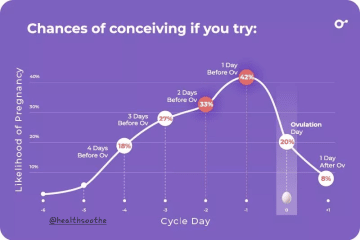When trying to conceive, it can be overwhelming to determine the perfect date and time to schedule sex with your partner! If you haven't been tracking your menstrual cycle, it can feel like you're taking shots in the dark, depending on luck instead of science.
If this sounds familiar, don't worry because we've got you covered! In this article, we have compiled everything you need to know about hitting that sweet spot - the elusive fertile window that can dramatically improve your chances of getting pregnant.
Let's break it down, one fact at a time!
Fact 1: The fertile window usually lasts for a period of 6 days in a month.
Before we dive into the details of the fertile window, we have to start with the basics.
Pregnancy is only possible when a male sperm meets a female egg through fertilization after unprotected sex. But, the female egg is only released once a month from a mature follicle in the ovary. This is called ovulation, and it is caused due to a sudden surge in a fertility hormone called Luteinizing Hormone (LH). Once the egg is released, it survives in the body for about 24 hours.
So, how long does the fertile window actually last?
Although each woman's menstrual period is different, you usually have a period of 60 hours or 2.5 days during each monthly cycle when the odds of pregnancy are relatively higher. However, the male sperm can survive in the female genital system for 3 to 5 days. Hence the male sperm can be alive (and swimming!) during and after ovulation. Pregnancy can occur four days before ovulation, the day of ovulation, or a day after ovulation. This time is known as your fertile window. The likelihood of getting pregnant increases significantly if you have sex during the fertile window of six days.
Fact 2: Depending on your menstrual cycle, your fertile window may vary from others.
Although most women who menstruate have a 28-day cycle, there are exceptions due to hormonal imbalances, stress, body weight, or medical issues. With this variation, you should note the first day of your period until the date of your next period to determine the timeframe of your menstrual cycle.
A person can get pregnant if they have sex between four days before and one day after ovulation, says the American College of Obstetricians and Gynecologists (ACOG).
So, now it's natural to wonder, "Should I have sex before, during, or after ovulation?"
Research shows that for the best chances of pregnancy, you should have sex every day or every alternate day during the following:
- Four days leading up to ovulation,
- Day of ovulation,
- Day after ovulation.
In fact, scientific studies revealed some fascinating numbers!
Here are your chances of getting pregnant based on the day you have sex:
- Four days before ovulation: 18%
- Three days before ovulation: 27%
- Two days before ovulation: 33%
- One day before ovulation: 42%
- Ovulation day: 20%
- 1 DPO: 8%

Fact 3: Experimenting with sex positions during your fertile window will not improve your chances of pregnancy.
While there is a lot of (mis)information about the different sexual positions that could improve your chances of pregnancy during your fertile window, there are no conclusive studies to back those claims. However, some have noted that some positions encourage deeper penetration, which could be better for conception because the sperm has a lesser distance to travel to reach the egg.
On the other hand, some experts noted that some lubricants used while experimenting with different positions might slow down the sperm's journey toward the egg and negatively impact conception. Therefore, it's essential to know which lubricants to avoid when having sex.
Some also say that an orgasm during vaginal sex helps with sperm transport. This seems plausible because the hormone oxytocin rises during and after an orgasm. This causes mild smooth muscle contraction, which may help sperm move from the vaginal canal through the cervix.
Ultimately, without any definitive proof, the best sex position seems to be the one you and your partner enjoy the most!
Fact 4: Keeping track of your fertile window will improve your chances of conception.
Tracking ovulation not only makes sense but it's proven to improve your odds of getting pregnant. Studies showed that tracking ovulation helped women enrolled in the program get pregnant within two cycles.
Fact 5: Narrowing down your fertile window is easier than you think!
At the end of the day, determining when you have ovulated will help you identify the fertile window before and after the date. This can help you plan sexual intercourse with your spouse so that you take advantage of the fertile window and improve your chances of conception.
Although it may seem intimidating, tracking your ovulation is easier than you may think. There are several ways to do so. Before choosing the method that works well for you, consider how regular your cycles are and if you have any coexisting medical conditions like PCOS that could interfere with accurate readings and interpretations.
Let's dive in and discuss the methods used to monitor ovulation.
Use a calendar:
Even though this is the easiest method that requires no equipment or testing, it may not suit everyone:
- It requires you to have a steady, regular cycle to accurately count the days to ovulation.
- It could get cumbersome and confusing to record the dates of your cycle manually.
- Even though the calendar method can track your period, it can only predict and not confirm ovulation has taken place.
Serial blood tests:
The most accurate way of determining your ovulation date is to track the levels of LH in your blood. This requires a series of blood tests taken at different points during your monthly cycle to identify a pattern. As you can imagine, this is not a preferred method of tracking ovulation because it is uncomfortable, painful, and expensive, especially if there are other more reasonable options. To confirm that you have actually ovulated, you will need to get your progesterone levels checked.
Record your basal body temperature (BBT):
BBT is your body's temperature when you are entirely at rest.
Your BBT should be recorded at the same time every day (usually the first thing in the morning). Keep a record of your daily readings. You will notice a slight temperature increase, typically 1/2 degree F (0.3 C) when you approach your ovulation day.
Once you identify a pattern over 2-3 cycles, you should have an idea about your ovulation dates for the next cycle, which will help you determine your fertile window.
Check your cervical mucus:
Studies reveal that tracking the changes in your cervical mucus can increase your chances of conceiving during your menstrual cycle. After washing your hands, you can insert two clean fingers into your vagina and hold the cervical mucus between your two fingers, stretching them away from each other. If you pay attention to the color and texture of the mucus over several days during your period, you will notice that it tends to get runny and thin, resembling egg whites as you approach your ovulation date. Making a note of these changes over 2-3 cycles can help you identify your ovulation day and your fertile window.
Use an ovulation predictor kit:
Ovulation predictor kits (OPKs) are similar to home pregnancy tests. They check your urine for luteinizing hormone (LH). Spikes in LH values point toward ovulation, suggesting that you will likely ovulate in the next 24 to 36 hours. Once you know your ovulation date, you can plan sex within your fertility window.
While this seems easy, you need to repeat these tests several times during the month to get an accurate idea about your baseline LH levels, so it may not suit everyone. In addition, these tests are also based on threshold values, which means that if your LH levels are naturally lower than the threshold of the tests, you could end up with false negative results.
Use a fertility monitor:
A fertility monitor that allows you to see the exact values of LH in your urine is the most efficient way to monitor your levels, detect an LH surge, and determine your fertile window.
Inito is an advanced fertility monitor that measures your LH, estrogen, follicle-stimulating hormone (FSH), and progesterone (PdG) in a single test. A rise in progesterone (PdG), which happens only after successful ovulation, helps to confirm ovulation accurately.
Your ovulation test is positive … Now what?
Finally! Your ovulation test reads positive. The next step is to have sex with your partner during the fertile window. Wait two weeks before getting a pregnancy test. The two-week period ends at about 12 days past ovulation.
Conclusion
Understanding the science behind your fertile window to determine your best chances of getting pregnant is extremely helpful. It helps you narrow down a specific period during your menstrual cycle, making planned intercourse much easier.
However, it's also important to note that not everyone's fertile window occurs at the same time of the month. So relying on accurate methods for testing fertility hormones, like LH, estrogen, FSH, and progesterone, may bring more success in the long run.



